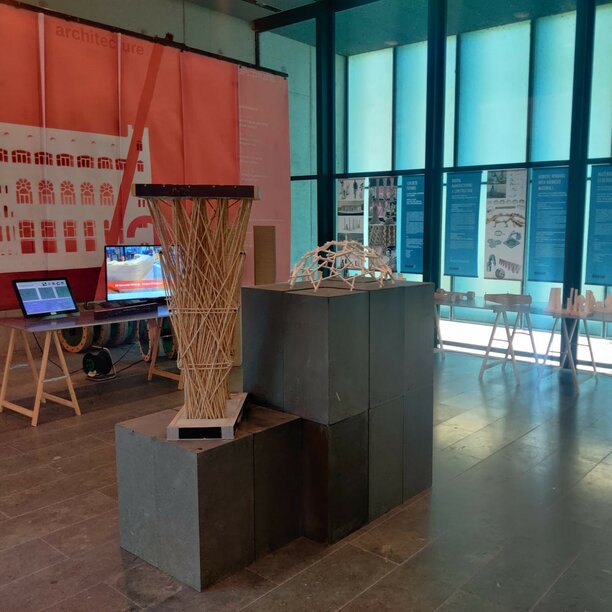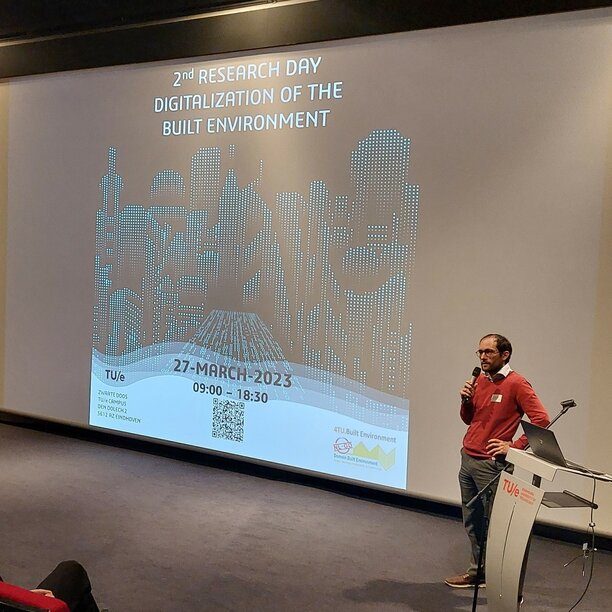Expositions and appearances
ROASD participates in expositions that showcase the latest advancements in robotics for the built environment. Our team of researchers actively contributes to these events by presenting their work and innovative solutions. These conferences and exhibitions provide a platform for us to share our knowledge, and stay up-to-date with the latest industry trends. At ROASD, we are committed to staying at the forefront of robotics research and development in the AEC industry, and these events play a vital role in achieving our goals.
![[Translate to English:] [Translate to English:]](https://assets.w3.tue.nl/w/fileadmin/_processed_/d/e/csm_17_exposition_947f416f0e.jpg)
ROASD EXPOSITION 2022
ROASD
At the end of the academic year of 2022, ROASD realized an exhibition where all members presented their current projects. This exposition included projects from all units within the faculty. This highlights the interconnectivity between the various discipliens within the built environment and the need for collaboration.
Arjan Habraken presented many of his students’ research on various processes involving robotics. An ongoing research track presented is the robotic winding of structures. Additionally, computational design such as reciprocal frame structures for dome structures was featured.
Rob Wolfs presented a selection of his work on 3D concrete printing, for which the faculty is well known. However, his work is not limited to the 3D printer, as shown by the various student projects for his Digital Design and Manufacturing course. In this course students learn to develop a design logic for the parametric designs, which are build at the end of the course by the robots. This also extends to the various graduation theses in which Rob guides. An example being Amy Hendriks her research on real-time correction of inaccuraties in robotic assembly of brick walls.
Cristina Nan presented the results of her Concrete Futures seminar, where students digitally design concrete columns. At the end of the seminar, a selection of these designs is realized by the project partner Vertico. Additionally, many small-scale prototypes are presented that are currently being printed by the new 3D clay printers. This research is currently gaining traction fast, and opens up many new exciting research opportunities for the unit.
Pieter Pauwels from the Information Systems group presented the results of his students from his Parametric Design course. Almost everything that is realized by robots, comes from a digitally designed model. Often, these models are realized using parametric design, and possibly generative algorithms. Parametric design is becoming increasingly important, and a skill graduated students should have to be prepared for the increasing digitalization within the field.
The exposition was a great succes, and showed other students and faculty what ROASD stands for. Additionally, it is a great example of the collaboration between all units of the faculty.

DIGITAL CRAFT - EHV INNOVATION CAFE
Cristina Nan
Construction with earth-based materials – an age-old tradition which was neglected until recently – is experiencing revival across the globe. The use of earth-based materials reduces more environmental impact than most other conventional building materials. In this talk, Cristina Nan will show prototypes and speculative works that explore the aesthetic expression of clay and earth via computational means and the use of neural networks, while moving beyond simple structural and constructive constraints.
Cristina Nan‘s research combines three streams of investigation: additive manufacturing, circularity and AI. She and her students explore these low-tech materials within a high-tech context of 3D-printing with clay and earth, computational design and AI.
RESEARCH DAY DIGITALIZATION OF THE BUILT ENVIRONMENT
Pieter Pauwels
On Monday the 27th of March the second 4TU/14UAS research day on digitalization of the built environment took place. The event highlights state-of-the-art research and implementation results related to the broader area of digitalization of the built environment, and is relevant for educators, teachers and students.
Advancements in technology such as Building Information Modelling (BIM), Artificial Intelligence (AI), Internet of Things (IoT), and Robotics have revolutionized the design, engineering, construction, and operation of the built environment. The use of digital technology can enhance performance, sustainability, and efficiency, and lead to better decision making, energy management, and holistic building design. These efforts aim to decarbonize, improve performance, indoor environmental quality, occupant comfort and well-being, safety, cost-efficiency, and productivity while reducing resource use, operational costs, and risks. Digital technology can also help establish best practices, predict progress and construction costs more accurately, identify desirable real estate, and track patterns of traffic, space utilization, and occupant behavior. Overall, digitalization is a key enabler in all aspects of the built environment.

